First, some great news on the academic front. One of the graduate student participants on GGI back in 2001 just completed his PhD at the University of California, Berkeley. Meet Dr. Joel Ledford, newly-minted world authority on spiders and explorer of Gulf of Guinea biodiversity. In the picture below, he is holding “bubba,” one of the three endemic tarantula species of São Tomé.
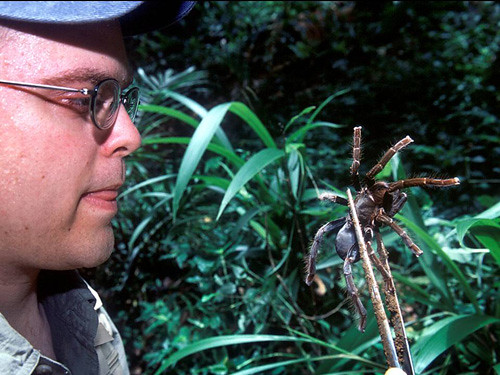
DR. Joel Ledford with Hysterocrates apostolicus. D. Lin phot. GGI
Readers of this blog already know that when we talk about biodiversity, we are talking about everything living, not just the big fancy stuff like birds and giant begonias. Many of the secrets of island evolution are to be unlocked through the study of small organisms. I have just received some preliminary news from Dr. Didier Van den Speigel of the Royal Central African Museum in Belgium. After Dr. Rowland Shelley of the North Carolina State Museum did a preliminary analysis of our GG IV millipede specimens, we sent them to Didier, a specialist on this group in the Old World. Rowland had concluded that we had at least one new species of the genus Globanus from each island.
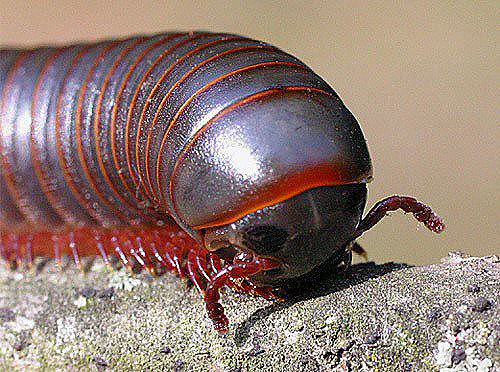
A millipede (not Globanus) phot. from cephalopodiatrist.com
Didier has examined material from other museums and has concluded that, in fact, the genus Globanus itself is endemic, found nowhere else in the world but the islands of São Tomé and Príncipe. We are still unsure of how many species our GG IV material represents, but what seems evident at this time is that they are all each other’s closest relatives. Drs Van den Speigel and Shelley are in agreement that this turns out to be the case, it would represent a “species swarm,” much like the endemic earthworms of São Tomé (see July 2010 blog “Nightmares….”, for an explanation). The work continues……
In my memorial to Abade last month, I described one of our early unsuccessful searches for Newton’s rocket frog during GG I.
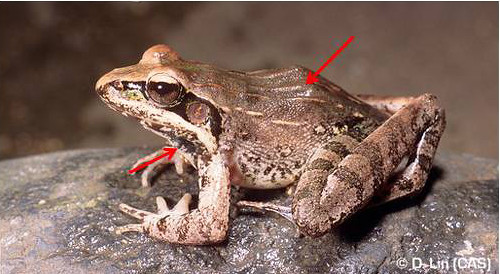
Newton's rocket frog, Ptychadena newtoni. D. Lin phot. GGI
This widely distributed genus of about 50 species is found throughout sub-Saharan Africa and distinguished by a sharp snout, paired vocal sacs (lower arrow), distinctive glandular ridges on the back (upper arrow) and very long legs. In fact a member of this group from South Africa holds the world record frog jump of over 33 feet (10m)! P. newtoni is one of São Tomé’s classic “island giants; at 76 mm (not including legs) a São Tomé female is much larger than any specimens of mainland species on record.
After days of visiting known localities mostly in and near the town of São Tomé and finding them dry, heavily disturbed and frogless, one rainy evening two young boys led us to a vacant lot less than 200m from where we were living, and there were the frogs! Ultimately, genetic analysis of these frogs established that they were, indeed, full endemic species, but also led John Measey, currently of South Africa, and a group of us to publish our rafting hypothesis in the Journal of Biogeography (2007 – see earlier blogs).
Our difficulty in finding this species in the northern lowlands of São Tomé (all of the known localities at the time) suggested to me that this may be the only endemic amphibian species on São Tomé that might be endangered due to human development.

Series of Ptychadena newtoni larvae from Java, Sao Tome. RCD phot. GG II
However, during GG II we found a series of tadpoles at Java (elevation 595m) which we later determined belonged to this species (although no adults were seen). Tadpoles are typically identified by various external characteristics, but especially by fine structures of the mouthparts. The drawings below are taken from a nearly completed manuscript that attempts to technically describe the tadpoles (larvae) of all the endemic island frog species; it has not been published because, even after all these years, we have still not found the larvae of the Príncipe giant treefrog, Leptopelis palmatus!
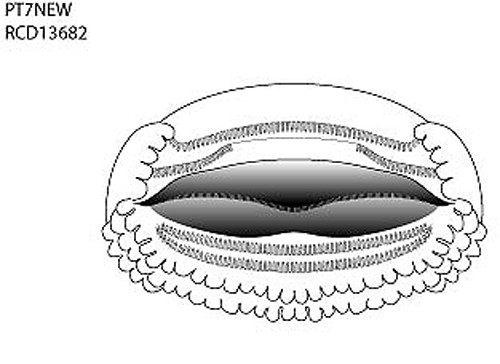 P. newtoni mouthparts from unpublished manuscript.
P. newtoni mouthparts from unpublished manuscript.

P. newtoni left lateral view from unpublished manuscript.
Our discovery of the Java larvae indicated that Newton’s rocket frog is not necessarily present only in the heavily developed northern lowlands.
Recently, a young biologist, Hugulay Maia, whom we first met during GG IV has found some new P. newtoni localities.
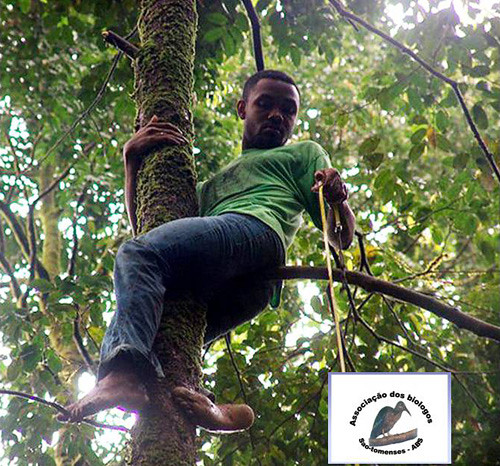
Hugulay Maia of ABS, doing tree work. unknown photographer]
Hugulay is a member of Associação dos Biologos (ABS), a local group of biologists involved in biodiversity efforts on São Tomé. The group is led by Dr. Alzira Rodrigues of the Polytechnic Institute; other members you have met in this blog are Angus Gascoigne and Victor Bomfim.
 Current P. newtoni localities: green = to 1992; pink = to date
Current P. newtoni localities: green = to 1992; pink = to date
Now, thanks to Hugulay’s observations (and photographs) we have a somewhat better idea of the distribution of Newton’s rocket frog. Earlier known localities are in green and were published by a Swiss worker in 1992; our GG II Java locality and Hugulay’s new localities are in pink. Hugulay’s data confirm that the species is not confined to the north. He has observed it at Colonia Açoreana (labeled) and two more southerly spots, Angra Toldo Cavaleite and Roça Alinhança.
The data are still thin, but we can at least infer that Ptychadena newtoni is more widespread than originally thought. Almost all of the mainland species breed in relatively still or slow-moving water, and it is reasonable to assume this is the case with Newton’s rocket frog. All of the old localities (in green) are associated with lowland reaches of major water courses: the city localities are in the Agua Grande drainage; Hugulay Maia’s new records are all from the Ribeira Afonsa drainage, and the Diogo Vaz locality (green symbol in the NW) is from the small Agua Anambo, which parallels the larger, much faster Rio Maria Luiza to south. Java our highest locality is on the Rio Abade, but the tadpoles were collected in a man-made pool in a roadside, partially dry creek bed, not in the river itself. To assess the actual status of Newton’s rocket frog, I think we just need to look more closely in bodies of slow or still water along major rivers throughout the island.
The Parting Shot:
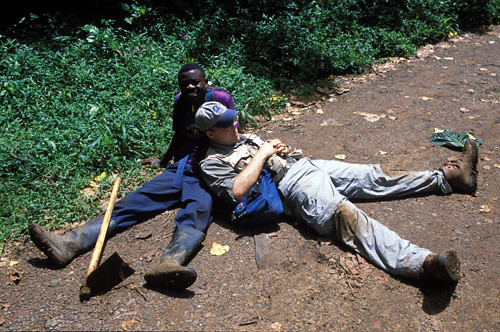
Dr. Joel Ledford: Spider hunters in repose. D. Lin phot. GG I
PARTNERS
We gratefully acknowledge the support of the G. Lindsay Field Research Fund, Hagey Research Venture Fund of the California Academy of Sciences, the Société de Conservation et Développement (SCD) and Africa’s Eden for logistics, ground transportation and lodging, STePUP of Sao Tome http://www.stepup.st/, Arlindo de Ceita Carvalho, Director General, and Victor Bomfim, Salvador Sousa Pontes and Danilo Barbero of the Ministry of Environment, Republic of São Tomé and Príncipe for permission to export specimens for study, the continued support of Bastien Loloum of Zuntabawe and Faustino Oliviera, Curator of the Herbarium at Bom Sucesso. Special thanks for the generosity of private individuals, George G. Breed, Gerry F. Ohrstrom, Timothy M. Muller, Mrs. W. H. V. Brooke, Mr. and Mrs. Michael Murakami, Hon. Richard C. Livermore, Prof. & Mrs. Evan C. Evans III, Mr. and Mrs. Robert M. Taylor, Velma and Michael Schnoll, and Sheila Farr Nielsen for helping make these expeditions possible. Our expeditions can be supported by donations to “California Academy of Sciences Gulf of Guinea Fund”.